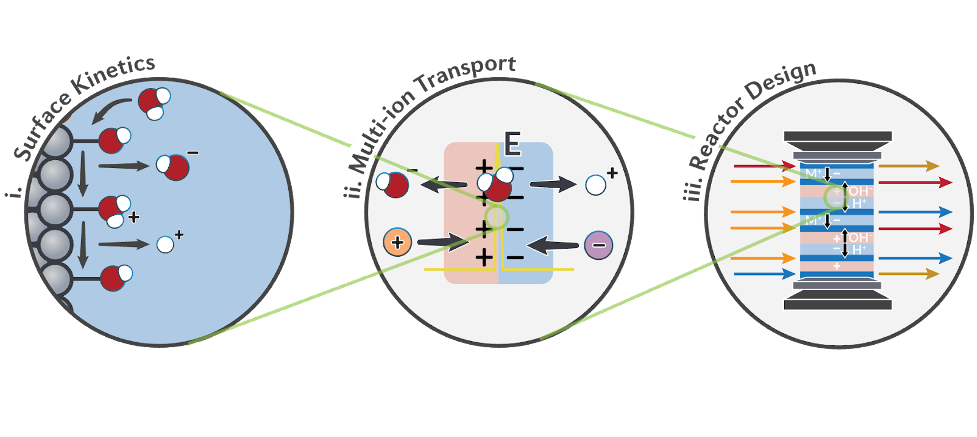Continuum modeling to resolve multiscale phenomena in bipolar membranes: From fundamental physics to application in carbon capture, utilization, and storage

Speaker
Justin Bui
Ph.D. Candidate
University of California, Berkeley
Abstract
Continuum modeling to resolve multiscale phenomena in bipolar membranes: From fundamental physics to application in carbon capture, utilization, and storage
1Liquid Sunlight Alliance, Lawrence Berkeley National Laboratory, 2Department of Chemical and Biomolecular Engineering, UC Berkeley
Bipolar membranes (BPMs) enable unprecedented control of ion concentrations and fluxes in electrochemical cells for a wide range of applications. To achieve this feat, BPMs facilitate the interconversion of applied electrical energy into pH gradients by leveraging large electric fields present at the interface of two oppositely charged ion-conducting polymers (> 108 V m–1) to drive the generation of local pH gradients through field-enhanced dissociation chemistry. However, these coupled ion transport and catalytic phenomena in BPMs were previously insufficiently understood. In this talk, I will present the multi-scale physics of BPMs within an electrochemical engineering context and articulate design principles aimed at driving the development of advanced BPM devices. The chemistry, structure, and physics of BPMs are illustrated and related to the thermodynamics, transport phenomena, and chemical kinetics that dictate ionic and molecular fluxes and selectivity. Through the development of a continuum model, we resolve the coupled interactions between species in the BPM that give rise to emergent structure-property-performance relationships and yield design criteria for BPMs needed to achieve high permselectivity and voltaic efficiency. The resulting performance tradeoffs for BPMs are presented in the context of the emerging applications of BPM carbon capture, utilization, and storage, demonstrating that optimization of the physicochemical properties of the BPM and catalyst layers, along with efficient management of multi-phase phenomena (e.g., bubble formation) are key to making BPM processes energetically competitive with established thermal processes for carbon capture and conversion. By connecting the fundamental physical phenomena in BPMs to device-level performance and engineering, we aim to facilitate the development of next-generation BPM devices for sustainable chemical processes.

Bio
Justin C. Bui is a Ph.D. candidate at UC Berkeley and the Lawrence Berkeley National Laboratory, where he is a researcher within the Liquid Sunlight Alliance DOE Hub. Justin earned his B.S. in Chemical Engineering from Columbia University, working with Prof. Daniel Esposito to fabricate membraneless electrolyzers for sustainable hydrogen production from seawater. As a Ph. D. candidate at Berkeley, Justin’s research with Prof. Alexis Bell and Dr. Adam Weber focused on the use of continuum-level theory to understand the impact of transport and catalysis in bipolar ion-conducting polymer membranes, as well as to elucidate the influence of the catalytic microenvironment on the activity and selectivity of carbon dioxide (CO2) electroreduction to value-added chemical products. Throughout his Ph.D., Justin worked closely with experimentalists to drastically advance the development of carbon capture and conversion devices. Justin is also the recipient of the prestigious NSF and NDSEG research fellowships. Beyond his scientific activities, Justin has also developed inclusive, experiential curricula to introduce K-12 students to electrochemistry. He will soon start as a postdoctoral scholar at Caltech, working with Prof. Karthish Manthiram to develop electrochemical reactors capable of oxidatively activating nitrogen to make plastics and fertilizer precursors directly from air.

